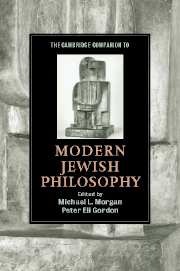Book contents
- Frontmatter
- 1 Introduction: Modern Jewish Philosophy, Modern Philosophy, and Modern Judaism
- 2 Baruch Spinoza and the Naturalization of Judaism
- 3 The Liberalism of Moses Mendelssohn
- 4 Jewish Philosophy after Kant The Legacy of Salomon Maimon
- 5 Hermann Cohen: Judaism and Critical Idealism
- 6 Self, Other, Text, God: The Dialogical Thought of Martin Buber
- 7 Franz Rosenzweig and the Philosophy of Jewish Existence
- 8 Leo Strauss and Modern Jewish Thought
- 9 Messianism and Modern Jewish Philosophy
- 10 Ethics, Authority, and Autonomy
- 11 Joseph Soloveitchik and Halakhic Man
- 12 Emmanuel Levinas: Judaism and the Primacy of the Ethical
- 13 Emil Fackenheim, the Holocaust, and Philosophy
- 14 Evil, Suffering, and the Holocaust
- 15 Revelation, Language, and Commentary: From Buber to Derrida
- 16 Feminism and Modern Jewish Philosophy
- Bibliography
- Index
12 - Emmanuel Levinas: Judaism and the Primacy of the Ethical
Published online by Cambridge University Press: 28 September 2007
- Frontmatter
- 1 Introduction: Modern Jewish Philosophy, Modern Philosophy, and Modern Judaism
- 2 Baruch Spinoza and the Naturalization of Judaism
- 3 The Liberalism of Moses Mendelssohn
- 4 Jewish Philosophy after Kant The Legacy of Salomon Maimon
- 5 Hermann Cohen: Judaism and Critical Idealism
- 6 Self, Other, Text, God: The Dialogical Thought of Martin Buber
- 7 Franz Rosenzweig and the Philosophy of Jewish Existence
- 8 Leo Strauss and Modern Jewish Thought
- 9 Messianism and Modern Jewish Philosophy
- 10 Ethics, Authority, and Autonomy
- 11 Joseph Soloveitchik and Halakhic Man
- 12 Emmanuel Levinas: Judaism and the Primacy of the Ethical
- 13 Emil Fackenheim, the Holocaust, and Philosophy
- 14 Evil, Suffering, and the Holocaust
- 15 Revelation, Language, and Commentary: From Buber to Derrida
- 16 Feminism and Modern Jewish Philosophy
- Bibliography
- Index
Summary
God tells us to be holy, not meaning that we ought to imitate Him, but that we ought to strive to approximate to the unattainable ideal of holiness.
Immanuel Kant, Lectures on Ethics (1775-1781)To every judge who judges truly, even for an hour, the Scripture reckons it as if he had been a partner with God in the work of creation.
B. Talmud, Tractate Shabbat, 10a.LEVINAS' ITINERARY
Emmanuel Levinas was born on January 12, 1906, in the Lithuanian city of Kaunas, known as “Kovno ” to both Poles and Jews. In 1923, at the age of sixteen, Levinas left Kovno to study philosophy at the University of Strasbourg in France. During the 1928-29 academic year, he studied in Freiburg under Edmund Husserl and Martin Heidegger. In 1930, he moved to Paris; married Raisa Levy, who as a child lived on the same block in Kovno as Levinas; became a French citizen; found employment at the École Normale Israelite Orientale; published academic articles on Husserlian phenomenology, his Strasbourg thesis, the prize-winning book The Theory of Intuition in Husserl’s Phenomenology (1930), and short pieces in Jewish journals on Jewish topics; and otherwise entered into the vibrant intellectual life of Paris. Conscripted into the French army in 1939, Levinas spent the war years in a German prisoner-of-war camp. After the war, he became Director of the École Normale Israelite Orientale, and in 1947 published his first two original philosophical books: Time and the Other2 and Existence and Existents. After the war, Levinas also began his Talmudic studies under the hidden Talmudic master known only as “Monsieur Shoshoni” or “Professor Shoshoni,” who was also at the same time teaching Elie Wiesel, amongst others.
- Type
- Chapter
- Information
- The Cambridge Companion to Modern Jewish Philosophy , pp. 234 - 255Publisher: Cambridge University PressPrint publication year: 2007
- 2
- Cited by



